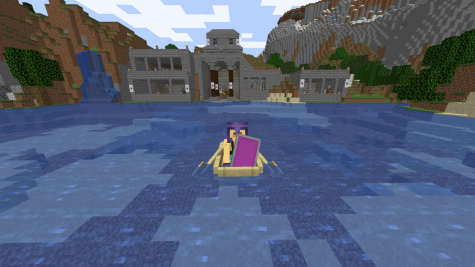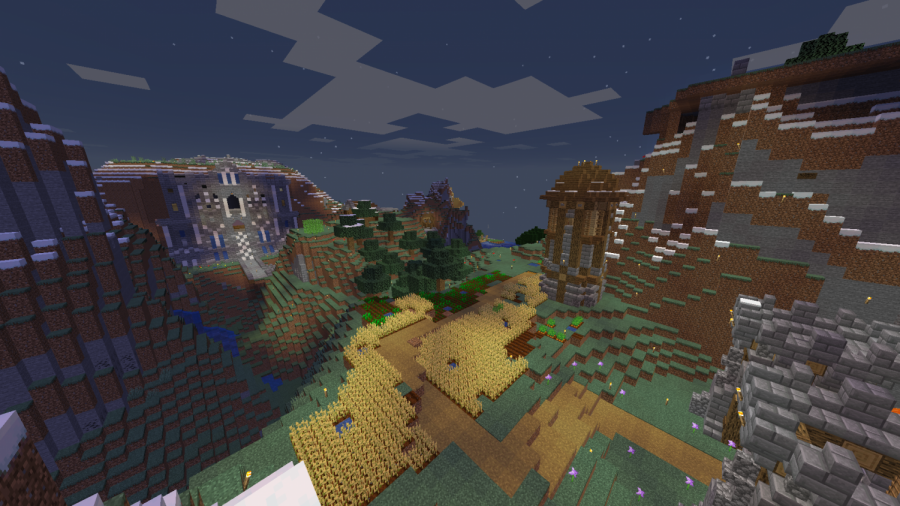Minecraft: How did it get where it is?
A bird’s-eye view of a Minecraft base.
November 25, 2020
It’s the amazing block game where you can build whatever you imagine and do whatever your heart desires. It’s an amazing, fun, addicting game that brings joy to the millions who play it on the regular. The game I’m talking about is Minecraft. But at one point, there was a time where it was completely unknown to the public. Minecraft was just a simple block game with not much to do except mess around with your friends and use whatever was in the game at that time. So how did Minecraft blow up and become the multi-billion dollar game it is today? And how did it gain so much popularity so fast?
It all started back in 2009 when Markus Persson, known as “Notch,” began to code a small game on the side called “Cave Game” with Java. He eventually released the game and gained attention from people who liked to code and design gaming worlds. Once the game was noticed, Notch decided to release an updated format of the game titled “Minecraft,” which was nothing like the Minecraft today that we know and love, and only included most of the basic stuff such as building, crafting, and gathering resources. Despite this,the game began to attract a massive following. This style of game was unique and it gathered lots of traction fast and made lots of players interested. The early builds of Minecraft also influenced future games, such as Terraria.
During 2009, Minecraft, due to its unique style and simplistic design, would have a major boom. Throughout the year, Minecraft would release updates with and new features, such as more mobs and new ores. This kept the player base at a rise and also attracted a new genre of players called modders, who added many new features, such as game modes like survival, and added a bunch of twists and ideas to the game. Notch noticed this and would take mods that the community that he loved and add some of them into the actual game. This further helped Minecraft take off and by the end of 2009, even though it was still in alpha, Minecraft’s popularity was rising.

By 2010, Minecraft was finally released to beta. Notch also quit his full-time job, choosing to focus on updating and releasing new versions of his game. Minecraft would then be noticed by a company called Mojang, which started to fund the development of the beta version during 2010. Due to Notch quitting his old job and also having mass funding from Mojang, Minecraft would be released fully in 2011. Minecraft’s full release was amazing, selling millions of copies of the full game all around the globe. But this was only the beginning of this block game.
Once the game was fully released, new updates would be released constantly. Cool things such as server hosting would be added, so it was easier to play with friends. Areas such as The End, which gave a new boss, the Ender Dragon, to the game, and the Nether, which is a hell-themed area that gave Nether Fortresses and new mobs, would be added, giving players more things to do and more bosses to defeat. There also would be new biomes, such as the forests and plains, which would come with new mobs and other materials, giving the game more spice and also making it more fun. To this day, updates like this are still coming out. Most recently there was the Nether revamp update, which added lots of new mobs and new biomes inside the Nether. Updates like this keep the player base active and also make the game more interesting and fun for the players.
“I have high hopes for this game. I could see it still being popular and still growing in a decade or so.” This was something Notch said in an interview conducted by GameSpot in 2011, and right now, what he said is true. Minecraft definitely won’t be dying anytime soon, with versions such as the caves and cliffs update coming in 2021. Minecraft is also on multiple different platforms now such as Xbox, PlayStation, and Switch. Because of this, there is a consistent influx of players from all these different consoles. Microsoft also recently acquired the right to the game for a staggering $2.5 billion from Mojang.
Consistent updates, new ownership, and the constant influx of new players from multiple different consoles is a sign that Minecraft isn’t disappearing anytime soon. From going from a simple block game to the biggest title that gaming has ever seen is incredible, and as things are looking, Minecraft isn’t even close to its apex.
